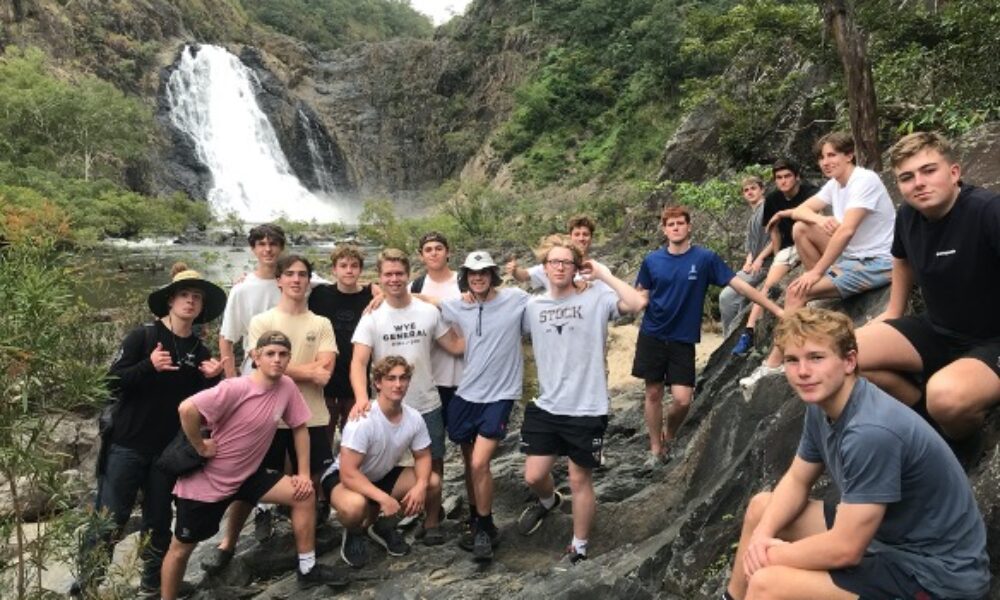
Buru
A Journey to the Aboriginal Homelands of the Far North.
– W. H. Wulff


CAPE YORK IS KNOWN FOR ITS REMOTENESS, natural beauty and strong indigenous culture, which our students were able to experience over the holidays. The trip itself was rich in information about the traditional practices and stories, as well as the many under-appreciated issues faced by remote communities.
One of the most striking things about the immersion were the notable differences in the perspectives of the Elders due to their geographical situation and relative dependence on the land. At Elim Beach, our first homeland, we were privileged to meet traditional owner Ivan Deemal and his cousin Robbie. They shared with us perspectives on culture, Indigenous knowledge about the land and their sacred sites, even commenting on contemporary Indigenous issues. We had the opportunity to visit their sacred site – the coloured sands, a spectacular and evocative canyon of red, white and orange sands hidden just behind the shrubbery along the beachfront.
Surprisingly, Robbie’s view on culture was less about preservation and focused on integration, conveying that some western practices are better substitutes for their traditional counterparts within the fields of medicine and other more developed services. However, in their opinion, Indigenous land management techniques still surpass any western alternatives. Ivan posed other interesting stances on hunting and fishing, explaining that if traditional (and restricted) food sources such as turtles and dugong were to be hunted, traditional practices should be used.
Robbie provided much insight into native title and the limited ownership that the Indigenous People have under the laws, which only allow for traditional practices and some limited business ventures. The essence of the problem is that the traditional owners are living in a westernised world but only have traditional rights over the land. So, for those who want to integrate western business and other practices into their use of the land, they will either not have the legal rights to do so or will have limited usage allowances. Indigenous People do not have mining rights to the land, but do have negotiation rights, so have a little influence over the introduction of mining to their land.
Surprisingly, Ivan’s perspective on mining was neither positive nor negative, as he saw the benefits and downsides for it. He and Robbie had stronger opinions on the mining rights themselves, given that they are not owned and controlled by the Indigenous People under the native title right. They both raised other issues such as public housing rates, which, for the Indigenous residents of the local area, were not indexed to the lower cost of living compared to urban residents. Similarly, their concern for households without a strong paternal figure was expressed and they worried about the career options that children considered without the guidance or example of a working father.
From Elim Beach, we moved to the town of Wujal Wujal, where we were greeted with a traditional smoking ceremony by elders Kathleen and Francis using the leaves of the Cooktown Ironwood tree and blood bark from the grass tree. We visited the sacred Wujal falls and played footy with the Indigenous children on the oval, before partaking in a traditional dance ceremony.
The next site was the healing centre at Buru where we met Eddie Madsen – the most remotely based of the Elders who lives on the intersection of rainforest and eucalypt forest in his hilltop abode. Eddie shared with us some of the bush tucker from the area and showed us the sacred site of caterpillar dreaming. This consisted of a healing pool enclosed by domed rocks in the middle of a vast area of bushland. This was traditionally a men’s only site, so depending on the Elder’s interpretation of the culture, it could be restricted to male only visitors (as it was on our trip).
Eddie shared much knowledge about his local culture and opinions on contemporary issues such as the need for Indigenous land management and the shortcomings of national parks. His opinion was that the national park land needed traditional management otherwise bushfires and other natural disasters would rage through the areas, as seen in the recent NSW and Victorian bushfires.
Surprisingly, his and the other Elders’ opinions on the issues of Australia Day, the national anthem and the national flag were all quite similar – that they weren’t going to change much and were far less important than legislation aiming to remedy many of the pressing problems Indigenous people face. Another surprising opinion was on the closing the gap initiative, which Eddie viewed as an attempted westernisation of Aboriginal people as it doesn’t have scope for retaining traditional culture.
Overall, the experience showed the range of Indigenous opinions on problems relevant to their lands. It showed that future approaches to policy require the close consultation of local Indigenous people and that solutions must be well tailored to suit different regions rather than a one-size-fits-all approach. Either way, it was an interesting and immersive experience which would benefit any Shore students who are interested. After all, a deeper awareness of the actual needs of those who have been forgotten can only help steer our nation in a better direction.
